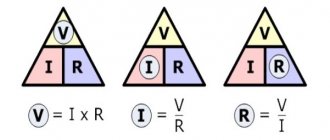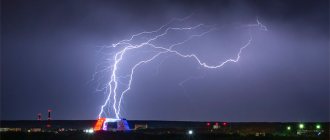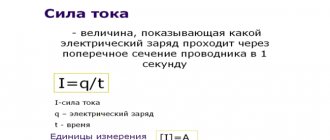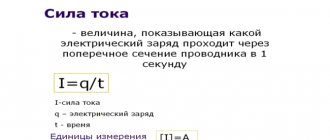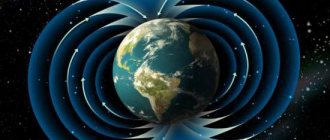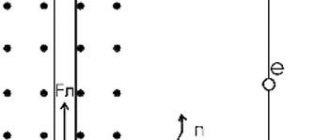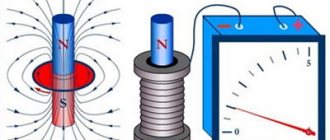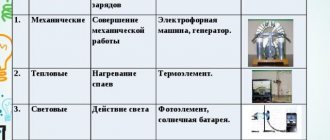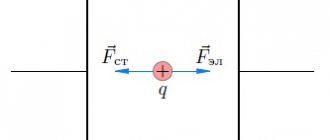Under what conditions does electric current occur and what is current strength in simple words
Let me immediately draw your attention: the definition of electric current does not apply to static, frozen phenomena. It is directly related to movement, a dynamic state.
It is created not by neutral, but by active particles of positive or negative electrical charge.
And they should not move chaotically, like residents of a metropolis during rush hour, but in a directional manner. Example: movement of a mass of cars along a multi-lane road in one direction in a large city.
Have you presented the picture? Cars from the side are added inside the continuous flow, some drivers move off the highway onto other roads. But these processes do not particularly affect the overall movement: the direction remains one-sided.
The movement of electric charges also occurs. Electrons create current inside metal conductors. In the normal state, they move there quite chaotically in all directions.
But as soon as an external force of electrical voltage is applied to them with positive and negative potentials at opposite ends of the conductor, the directed movement of charges begins.
It is an electric current. I draw your attention to the last word. It characterizes flow, movement, movement, dynamics and related processes, but not statics.
It is the magnitude of the applied external force that determines the quality of the directional flow of electrons in one direction. The higher its value, the greater the current begins to flow through the conductor.
However, here you need to take into account several features related to:
- generally accepted scientific conventions;
- intensity of movement of charges;
- Reaction from the internal environment of the conductor.
In the first case , we have to overcome established historical stereotypes when people confuse the general direction of electrons and electric current.
All scientific calculations are based on the fact that the direction of the current is taken to be the movement of charged particles from the plus of the voltage source to its minus.
Inside metals, an electric current is created by moving electrons in the opposite direction: they are repelled from the negative pole of the same name and move towards the positive one.
Misunderstanding of this provision may lead to errors. But they are easy to avoid: you just need to remember this feature and use it when calculating or analyzing the actions of electrical circuits.
The intensity of movement of charged particles is characterized by the amount of their charge flowing through a given area in a certain period of time.
It is called the current strength, denoted by the Latin letter I, and calculated by the ratio ∆Q/∆t.
Here ∆Q is the number of charges passing through a conductor of area S and length ∆L, and ∆t is a calibrated time interval.
To increase the current, we need to increase the number of charges passing through the conductor per unit time, and to decrease it, reduce it.
Again, take a closer look at the term “current strength”, or rather at its first word. I specifically showed a powerful biceps and a smoldering light bulb for comparison in the very top picture.
The power reserve of an energy source can vary from excessive to insufficient for the consumer. And we always need to power the load optimally. For this purpose, the concept of current strength was introduced.
To evaluate it, a unit of measurement is used: ampere, denoted by the Latin letter A.
Theoretically, to estimate 1 ampere you need:
- take two very thin, infinitely long and completely smooth conductors;
- place them on a plane strictly parallel to each other at a distance of 1 meter;
- pass the same current through them, gradually increasing its value;
- measure the force of attraction of the wires and record the moment when it reaches a value of 2 × 10-7 Newton.
That’s when 1 ampere will begin to flow in the wires.
In practice, no one does this. Special instruments have been created for measurement: ammeters. Their designs work in length and multiplicity sizes: milli-, micro- and kilo-.
Another definition of ampere is related to the unit of quantity of electricity: the coulomb (C) that passes through the cross-section of a wire in 1 second.
1A = 1Kl / 1c
The strength of the current anywhere in a closed electrical circuit where it flows is always the same , and when it breaks, wherever it is, it disappears.
This phenomenon allows you to take measurements in the most convenient places of any electrical circuit.
When a complex branched circuit is created for the flow of several currents, the latter also remain constant in all individual sections.
The third case of environmental resistance is also important. As electrons move, they encounter obstacles in the form of positively and negatively charged particles.
Such collisions are associated with the expenditure of energy spent on heat generation. They were generalized by the term electrical resistance and described by physical laws in mathematical form.
The internal structure of each metal has different resistance to the flow of current. Science has long studied these properties and compiled them into tables, graphs and formulas for electrical resistivity.
When making calculations, we can only use already verified and prepared information. They can be performed based on the formulas presented in the well-known electrician's cheat sheet.
But it is much easier to use the online Ohm's Law calculator. It will help you avoid making common mathematical mistakes.
For those who like to watch videos, I recommend Pavel Victor’s video on the basics of the theory of electrical conductivity of metals.
The most important conclusions from current formulas for the home handyman
Practical benefit is provided only by a complete understanding of the processes of current flow through conductors. In everyday life we should:
- Provide for current loads on the wiring in advance. This information will help you correctly design it for installation inside your apartment. And if it has already been laid, then it will be necessary to take into account and not exceed the connected power.
- Eliminate typical errors in the installation of wires and equipment, which result in unnecessary loss of electrical energy, excessive heating, and damage.
- Use the wiring correctly.
- Provide a protection system that will automatically protect the household network from accidental damage both inside the circuit and coming from the power supply.
Now I will not decipher each of these four points in more detail. I have plans to describe them for you in more detail in a series of articles and publish them in the sections of the site. Follow the information or subscribe to the newsletter to stay informed.
Test with answers: “Electric current”
1. What is called electric current: a) directed movement of electrons b) directed movement of charged particles + c) directed movement of particles
2. What is necessary for an electric current to arise in a conductor: a) the creation of an electric field in the conductor + b) the action on electrons of forces causing their movement c) electrify the conductor
3. The purpose of the current source is: a) to create electric charges in the conductor b) to free electrons in the conductor from bonding with atoms c) to maintain the existence of an electric field in the conductor +
4. In all current sources this process occurs: a) separation of positively and negatively charged particles + b) accumulation of electrons or ions c) creation of flows of charged particles
5. The poles of a current source are the places where: a) electric charges interact b) electric charges are separated c) electric charges of different signs accumulate +
6. What poles and their number does the current source have? a) 3; positive, negative and neutral b) 2; positive and negative + c) 2; negative and neutral
7. To separate electrical charges in a current source, the following energy is required: a) chemical b) mechanical c) internal d) all answers are correct +
8. In a galvanic cell, the separation of charged particles occurs due to this energy: a) energy of chemical reactions + b) light energy c) internal
9. What serves as a positive electrode in a galvanic cell, and what serves as a negative: a) positive - resin layer, negative - zinc vessel b) positive - carbon rod, negative - zinc vessel + c) positive - carbon rod, negative - paste
10. The battery produces electric current only after: a) it has been charged from another current source + b) it has been warmed in a warm room c) its electrodes have been electrified
11. The direction of electric current is conventionally taken to be the direction in which the following move in the conductor: a) electrons and negative ions b) negative ions c) positive ions +
12. When electric current flows through solutions of salts, substances are released in solutions. This manifests itself: a) the thermal effect of current b) the chemical effect of current + c) the magnetic effect of current
13. With a current of 4 A with an electrical resistance of 2 Ohms, what is the voltage on the circuit section: a) 8 V + b) 2 V c) 16 V
14. If the voltage is increased by 4 times, and the resistance remains unchanged, how will the current strength in the circuit section change: a) decrease by 4 times b) will not change c) increase by 4 times +
15. Resistors with a resistance of 2 Ohms and 3 Ohms are connected in series. You must choose the correct statement: a) the current in the first resistor is less than in the second b) the total resistance of the resistors is more than 3 Ohms + c) the total resistance of the resistors is 1.2 Ohms
16. The wire was cut in half and folded in half. Will her resistance change? a) will not change b) will increase by 4 times c) will decrease by 4 times +
17. What is necessary for an electric current to arise in a conductor: a) only create an electric field in it + b) only the presence of free electric charges in it c) only have a consumer of electrical energy
18. The fuse design is based on the action of electric current: a) chemical b) thermal + c) magnetic
19. Resistances of 2 Ohms and 3 Ohms are connected in parallel to each other in an electrical circuit. The smaller of them carries a current of 6 A. The larger of them carries a current: a) 4 A + b) 2 A c) 3 A
20. Current strength is measured in: a) Joules b) Ohms c) Amperes +
21. What kind of electric current can be: a) charged and uncharged b) short-term and long-term + c) fast and slow
22. Under normal conditions, gas: a) does not conduct electric current + b) conducts electric current c) may or may not conduct current depending on the type of gas
23. Current begins to exist when: a) when molecules begin to move chaotically b) free charges appear + c) when gas molecules begin to collide with each other
24. What types of electric current discharges exist: a) independent + b) limited c) unlimited
25. Which discharge can be called the weakest: a) smoldering b) quiet + c) spark
26. What is called recombination: a) a similar ionization process b) occurs simultaneously with ionization c) the reverse ionization process +
27. As a result, an electric current occurs in gases: a) ionization + b) temperature decrease c) molecular splitting
28. Which of the electric current discharges is used in bactericidal lamps: a) arc b) spark c) glow +
29. What are the names of discharges that exist while they are acted upon by a body from outside: a) glow discharges b) non-self-sustained discharges + c) independent discharges
30. What is called an electric field: a) a special type of matter that manifests itself in action on electric charges + b) a type of matter that has electric charges c) a special type of matter that manifests itself in action on moving electric charges
What are the types of electric current in everyday life?
The shape of the current signal depends on the operation of the voltage source and the resistance of the medium through which the signal passes. Most often in practice, a home craftsman has to deal with the following types:
- a constant signal generated from batteries or galvanic cells;
- sinusoidal, created by industrial generators with a frequency of 50 hertz;
- pulsating, formed by transformations of various power supplies;
- pulsed, penetrating into the household network due to lightning discharges into overhead power lines;
- arbitrary.
The most common type is sinusoidal or alternating current: it powers all our devices.
Many semiconductor household appliances operate in modern wiring powered by sinusoidal voltage. They have non-linear resistance and violate the harmonic shape.
These noises accumulate throughout the entire circuit from a specific consumer to the supply transformer, distorting the ideal sine wave in an arbitrary manner. As a result, both the shape and magnitude of the supply voltage changes.
This can lead to the creation of an emergency mode: burning out of the neutral conductor in the three-phase supply circuit. This process is described in detail in a separate article on another site.
1.8. Electricity. Ohm's law
If an insulated conductor is placed in an electric field, then a force will act on the free charges q in the conductor. As a result, a short-term movement of free charges occurs in the conductor. This process will end when the own electric field of the charges arising on the surface of the conductor completely compensates for the external field. The resulting electrostatic field inside the conductor will be zero (see § 1.5).
However, in conductors, under certain conditions, continuous ordered movement of free electric charge carriers can occur. This movement is called electric current. The direction of the electric current is taken to be the direction of movement of positive free charges. For an electric current to exist in a conductor, an electric field must be created in it.
A quantitative measure of electric current is the current strength I - a scalar physical quantity equal to the ratio of the charge Δq transferred through the cross section of the conductor (Fig. 1.8.1) over the time interval Δt to this time interval:
If the strength of the current and its direction do not change over time, then such a current is called constant.
| Figure 1.8.1. Ordered movement of electrons in a metal conductor and current I. S – cross-sectional area of the conductor, – electric field |
In the International System of Units (SI) current is measured in amperes (A). The current unit of 1 A is established by the magnetic interaction of two parallel conductors with current (see § 1.16).
A direct electric current can only be created in a closed circuit in which free charge carriers circulate along closed trajectories. The electric field at different points of such a circuit is constant over time. Consequently, the electric field in a direct current circuit has the character of a frozen electrostatic field. But when an electric charge moves in an electrostatic field along a closed path, the work done by electric forces is zero (see § 1.4). Therefore, for the existence of direct current, it is necessary to have a device in the electrical circuit that is capable of creating and maintaining potential differences in sections of the circuit due to the work of forces of non-electrostatic origin. Such devices are called direct current sources. Forces of non-electrostatic origin acting on free charge carriers from current sources are called external forces.
The nature of external forces may vary. In galvanic cells or batteries they arise as a result of electrochemical processes; in direct current generators, external forces arise when conductors move in a magnetic field. The current source in the electrical circuit plays the same role as the pump, which is necessary to pump fluid in a closed hydraulic system. Under the influence of external forces, electric charges move inside the current source against the forces of the electrostatic field, due to which a constant electric current can be maintained in a closed circuit.
When electric charges move along a direct current circuit, external forces acting inside the current sources perform work.
A physical quantity equal to the ratio of the work Ast of external forces when moving a charge q from the negative pole of a current source to the positive pole to the value of this charge is called the electromotive force of the source (EMF):
Thus, the EMF is determined by the work done by external forces when moving a single positive charge. Electromotive force, like potential difference, is measured in volts (V).
When a single positive charge moves along a closed direct current circuit, the work done by external forces is equal to the sum of the emf acting in this circuit, and the work done by the electrostatic field is zero.
A DC circuit can be divided into separate sections. Those areas where no external forces act (i.e. areas that do not contain current sources) are called homogeneous. Areas that include current sources are called inhomogeneous.
When a single positive charge moves along a certain section of the circuit, work is performed by both electrostatic (Coulomb) and external forces. The work of electrostatic forces is equal to the potential difference Δφ12 = φ1 – φ2 between the initial (1) and final (2) points of the inhomogeneous section. The work of external forces is equal, by definition, to the electromotive force 12 acting in a given area. Therefore the total work is equal to
| U12 = φ1 – φ2 + 12. |
The value U12 is usually called the voltage in circuit section 1–2. In the case of a homogeneous area, the voltage is equal to the potential difference:
| U12 = φ1 – φ2. |
The German physicist G. Ohm experimentally established in 1826 that the current strength I flowing through a homogeneous metal conductor (i.e., a conductor in which no external forces act) is proportional to the voltage U at the ends of the conductor:
where R = const.
The value R is usually called electrical resistance. A conductor that has electrical resistance is called a resistor. This relationship expresses Ohm's law for a homogeneous section of the circuit: the current strength in the conductor is directly proportional to the applied voltage and inversely proportional to the resistance of the conductor.
The SI unit of electrical resistance of conductors is the ohm (Ω). A resistance of 1 ohm has a section of the circuit in which a current of 1 A occurs at a voltage of 1 V.
Conductors that obey Ohm's law are called linear. The graphical dependence of the current I on the voltage U (such graphs are called current-voltage characteristics, abbreviated as VAC) is depicted by a straight line passing through the origin of coordinates. It should be noted that there are many materials and devices that do not obey Ohm's law, for example, a semiconductor diode or a gas-discharge lamp. Even with metal conductors, at sufficiently high currents, a deviation from Ohm’s linear law is observed, since the electrical resistance of metal conductors increases with increasing temperature.
For a section of a circuit containing an emf, Ohm's law is written in the following form:
| IR = U12 = φ1 – φ2 + = Δφ12 + . |
This relationship is usually called the generalized Ohm's law or Ohm's law for an inhomogeneous section of the chain.
In Fig. 1.8.2 shows a closed DC circuit. The chain section (cd) is uniform.
| Figure 1.8.2. DC circuit |
According to Ohm's law
| IR = Δφcd. |
Section (ab) contains a current source with an emf equal to .
According to Ohm's law for a heterogeneous area,
| Ir = Δφab + . |
Adding both equalities, we get:
| I (R + r) = Δφcd + Δφab + . |
But Δφcd = Δφba = – Δφab. That's why
This formula expresses Ohm's law for a complete circuit: the current strength in a complete circuit is equal to the electromotive force of the source divided by the sum of the resistances of the homogeneous and inhomogeneous sections of the circuit.
Resistance r of the inhomogeneous section in Fig. 1.8.2 can be considered as the internal resistance of the current source. In this case, section (ab) in Fig. 1.8.2 is the internal portion of the source. If points a and b are closed with a conductor whose resistance is small compared to the internal resistance of the source (R << r), then a short circuit current will flow in the circuit
Short circuit current is the maximum current that can be obtained from a given source with electromotive force and internal resistance r. For sources with low internal resistance, the short circuit current can be very high and cause destruction of the electrical circuit or source. For example, lead-acid batteries used in automobiles can have short-circuit currents of several hundred amperes. Short circuits in lighting networks powered from substations (thousands of amperes) are especially dangerous. To avoid the destructive effects of such large currents, fuses or special circuit breakers are included in the circuit.
In some cases, to prevent dangerous values of short circuit current, some external resistance is connected in series to the source. Then the resistance r is equal to the sum of the internal resistance of the source and the external resistance, and during a short circuit the current strength will not be excessively large.
If the external circuit is open, then Δφba = – Δφab = , i.e., the potential difference at the poles of an open battery is equal to its EMF.
If the external load resistance R is turned on and current I flows through the battery, the potential difference across its poles becomes equal to
| Δφba = – Ir. |
In Fig. 1.8.3 shows a schematic representation of a direct current source with an equal emf and internal resistance r in three modes: “idling”, load operation and short circuit mode (short circuit). The electric field strength inside the battery and the forces acting on the positive charges are indicated: – electric force and – external force. In short circuit mode, the electric field inside the battery disappears.
| Figure 1.8.3. Schematic representation of a direct current source: 1 – battery open; 2 – battery is closed to external resistance R; 3 – short circuit mode |
To measure voltages and currents in DC electrical circuits, special instruments are used - voltmeters and ammeters.
A voltmeter is designed to measure the potential difference applied across its terminals. It is connected in parallel to the section of the circuit on which the potential difference is measured. Any voltmeter has some internal resistance RB. In order for the voltmeter not to introduce a noticeable redistribution of currents when connected to the circuit being measured, its internal resistance must be large compared to the resistance of the section of the circuit to which it is connected. For the circuit shown in Fig. 1.8.4, this condition is written as:
| RB >> R1. |
This condition means that the current IB = Δφcd / RB flowing through the voltmeter is much less than the current I = Δφcd / R1 that flows through the circuit section being tested.
Since there are no external forces acting inside the voltmeter, the potential difference at its terminals coincides, by definition, with the voltage. Therefore, we can say that a voltmeter measures voltage.
An ammeter is designed to measure current in a circuit. The ammeter is connected in series to an open circuit so that the entire measured current passes through it. The ammeter also has some internal resistance RA. Unlike a voltmeter, the internal resistance of an ammeter must be quite small compared to the total resistance of the entire circuit. For the circuit in Fig. 1.8.4 The resistance of the ammeter must satisfy the condition
| RA << (r + R1 + R2), |
so that when the ammeter is turned on, the current in the circuit does not change.
Measuring instruments - voltmeters and ammeters - come in two types: pointer (analog) and digital. Digital electrical meters are complex electronic devices. Typically, digital instruments provide higher measurement accuracy.
| Figure 1.8.4. Connecting an ammeter (A) and a voltmeter (B) to an electrical circuit |
Electric current in various environments: what an electrician needs to know
Charged particles under the influence of applied voltage move not only inside metals, as we discussed above using electrons as an example, but also in:
- transition layer of semiconductor elements;
- liquids of various compositions;
- gas environment;
- and even inside a vacuum.
All of these media are rated by their ability to pass current using a term called conductivity. This is the reciprocal of resistance. It is designated by the letter G and is evaluated through specific conductivity, which can be found in the tables.
Conductivity is calculated using the formulas:
G=1/R=I/U
Current strength in a metal conductor: how it is used in domestic conditions
The ability of the internal structure of metals to differently influence the conditions of movement of directed charges is used to implement specific tasks.
Transportation of electrical power
To transmit electrical energy over long distances, metal conductors of increased cross-section with high conductivity are used: copper or aluminum. The more expensive metals silver and gold work inside complex electronic circuits.
All kinds of designs of wires, cords and cables based on them are reliably used in home wiring.
Heating elements
Tungsten and nichrome, which have high resistance, are used for heating devices. It allows the conductor to be heated to high temperatures with the correct selection of applied power.
This principle is embodied in numerous designs of electric heaters - heating elements.
Protective devices
The increased current strength in a metal conductor with good conductivity but a thin cross-section makes it possible to create fuses used as current protection.
They work normally under optimal load conditions, but quickly burn out during voltage surges, short circuits or overloads.
For several decades, fuses massively served as the main protection for home wiring. They have now been replaced with circuit breakers. But inside all power supplies they continue to work reliably.
Current in semiconductors and its characteristics
The electrical properties of semiconductors strongly depend on external conditions: temperature, light irradiation.
To increase their own conductivity, special impurities are added to the structure.
Therefore, inside the semiconductor, the current is created due to the intrinsic and impurity conductivity of the internal pn junction.
The charge carriers of a semiconductor are electrons and holes. If the positive potential of the voltage source is applied to pole p, and the negative potential to pole n, then current will flow through the pn junction due to the movement they create.
When the polarity is applied in reverse, the pn junction remains closed. Therefore, in the picture above, in the first case, a light bulb is shown, and in the second, an extinguished one.
Similar pn junctions work in other semiconductor designs: transistors, zener diodes, thyristors...
All of them are designed to carry rated current. To do this, markings are applied directly to their body. Using it, they enter the tables of technical reference books and evaluate the semiconductor based on its electrical characteristics.
Current in Liquids: 3 Application Methods
If metals have good conductivity, then the liquid medium can act as a dielectric, conductor, and even semiconductor. But the latter case is not for home use.
Insulating properties
Mineral oil of high purity and low viscosity, created for use inside industrial transformers, has high dielectric properties.
Distilled water also has high insulating properties.
§ 47. Current sources
Chapter 7. Electric current- What types of energy do you know?
1. Let us recall that for the existence of an electric current in a conductor, it is necessary to create and maintain an electric field in it. An electric field in conductors is created and can be maintained by sources of electric current .
In the current source, work is done to separate positively and negatively charged particles. These separated particles accumulate at the poles of the current source . One pole is charged positively, the other negatively.
An electric field is formed between the poles of the current source, and if you connect them with a conductor, then the field will also arise in the conductor. Free charged particles in the conductor (electrons) will begin to move in an orderly manner under the influence of this field, i.e., an electric current will arise in the conductor.
2. In any current source, work is done to separate charged particles. In this case, various types of energy (mechanical, chemical, internal) are converted into electrical energy.
For example, the conversion of mechanical energy into electrical energy occurs in an electrophore machine (Fig. 142). When the handle of the machine rotates, its plastic discs, located at a short distance from each other, begin to move. Rotating in opposite directions, the disks electrify each other. Foil plates applied to the disks come into contact with the metal brushes of the electrophore machine, which transfer the charge to the balls. A continuous separation of charges occurs, as a result of which one of the balls of the electrophore machine is charged positively, the other - negatively. If you connect them with a conductor, then an electric current will flow through it.
3. The transformation of internal energy into electrical energy can be observed in the following experiment. If you heat the junction of two wires made of different metals (Fig. 143), the device will detect an electric current. Such a current source is called thermoelement .
4. In a galvanic cell (battery) (Fig. 144), charges are separated during chemical reactions, and the internal energy released during these reactions is converted into electrical energy.
Let us consider in more detail the structure of the galvanic cell and battery, which were one of the first sources of current and are currently used by pi.
These current sources received their name in honor of the Italian physician, professor of anatomy Luigi Galvani (1737-1798).
The history of physics knows many discoveries that arose by chance. A striking example of such a discovery is the experiment of Galvani, already known to you. The scientist studied the nervous system of the frog. Quite by accident, touching the nerves of a dissected frog with the tip of a scalpel, he discovered a contraction of the muscles of its leg. The phenomenon was so unusual and unexpected, and the reasons so incomprehensible that, as Galvani wrote, he was “kindled with incredible zeal and a passionate desire to explore this phenomenon and bring to light what was hidden in it.”
Continued >>>
